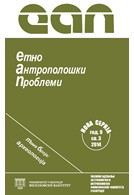Arheološki izlet u pograničnu koloniju
Archaeological Excursion into Proximal Colony
Author(s): Aleksandar PalavestraSubject(s): Archaeology
Published by: Филозофски факултет, Универзитет у Београду
Keywords: Austro-Hungarian Empire; proximal colonialism; frontier Orientalism; archaeology; anthropology; congress; Landesmuseum in Sarajevo
Summary/Abstract: Austro-Hungarian rule in Bosnia-Herzegovina by the end of the 19th century, presided by Benjamin Kallay, the Empire’s Minister of Finance and governor of Bosnia and Herzegovina, strived to gain wider international justification for its years’ long project of “civilizing” Bosnia and Herzegovina, or particular “historizing” of this proximal colony. In the summer of 1894 the Austro-Hungarian government in Bosnia and Herzegovina organized the Congress of Archaeologists and Anthropologists in the Landesmuseum in Sarajevo. The aim of the Congress was to inform archaeologists and anthropologists about the results of archaeological investigations in the country, and to seek their advice in directing further work. The wider ideological, political, as well as theoretical context of this congress, however, was much more complex and layered, with the aim to present the constructed image of Bosnia and Herzegovina as a country of tamed and civilized European Orient of rich past and luxurious folklore. The participants of the Congress discussed the archaeological and anthropological data presented to them by the hosts, including the specially organized excavations at Butmir and Glasinac. It is interesting to analyze, from the point of view of the history of archaeological ideas, the endeavours of the participants to adapt the archaeological finds before them to the wishes of the hosts, and, on the other hand, to their favoured archaeological paradigms dominant at the time.
Journal: Етноантрополошки проблеми
- Issue Year: 9/2014
- Issue No: 3
- Page Range: 669-695
- Page Count: 27
- Language: Serbian

